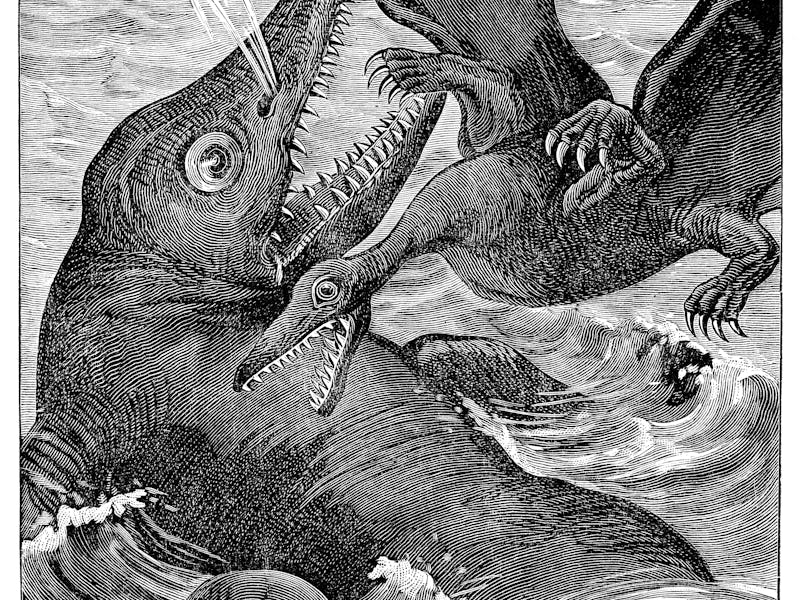Ancient aquatic megapredator was way more metal than scientists realized
"We had never found something this complete in the stomach of a giant reptile before."

Scientists already knew that Ichthyosaurs were a gnarly group of predators. The ancient reptiles, whose name means "fish lizards," could reach 85 feet long. They were literal sea monsters that topped the marine food chain who used specialized teeth for the grasping — not cutting — and devouring of soft animals like cephalopods and fish.
It turns out these oceanic hunters still haven't received the credit they deserve. In a new discovery, researchers unveiled surprising contents inside the stomach of a Guizhouichthyosaurus specimen — findings that give Ichthyosaurs further clout when it comes to their hunting skills.
In the study, scientists report finding the skeleton of a 13-foot-long lizard, a thalattosaur, inside the stomach of a Guizhouichthyosaurus. It's likely the "oldest evidence for predation on megafauna," which refers to prey larger than a human. The study appeared Thursday in the journal iScience.
The fossils came from a quarry in southwestern China. They demonstrate an impressive feat: The ichthyosaur carrying about its 13-foot-long prey was only about 16 feet long itself.
The discovery also provides evidence that Ichthyosaurs — and perhaps other creatures with similar dental makeup — could take on prey much larger than a cephalopod.
Ryosuke Motani, a professor at the University of California Davis, led the study. He tells Inverse food remains in fossilized stomachs are usually fragmentary, typically just a few bones "that are damaged and etched by stomach acid."
"We had never found something this complete in the stomach of a giant reptile before," Motani says.
Close-up of the ichthyosaur's stomach area.
Rethinking megapredation — When the team discovered what was inside, it caught researchers off-guard.
"I thought we were in trouble," Motani says. "We now had to figure out what species was in the stomach and how it got there, yet neither looked straight forward."
Once researchers were able to identify both predator and prey, that "trouble" led to some curious scientific ideas about predatory behavior during the Mesozoic period. Previously, researchers hypothesized about Ichthyosaurs' based on their teeth, since well-preserved stomach contents are hard to come by.
Ichthyosaurs' teeth are designed for grasping, not slicing, prey. That made the idea that they fed on small, soft-bodied animals, like cephalopods, was a good bet.
Yet the newly reported specimen swallowed a thalattosaur body in "one to several pieces," the researchers write.
That was a game-changer. The research team had to reconsider what they assumed about the behavior of Guizhouichthyosaurus, and reptiles with grasping teeth in general. The finding suggests that this kind of predation was likely more widespread than previously believed.
"We are now sure that more ichthyosaurs than we thought before were megapredators," Motani says. "Also, we now know that megapredation started almost simultaneously in multiple groups of ichthyosaurs back in time."
Ichthyosaur's teeth. The broken white line indicates the approximate gum line of the upper jaw.
Motani says the large quarry in China, where the specimen was discovered, was developed "just for the purpose of finding fossils, not for mining," which is unique.
"It is a good location because many fossils of marine reptiles, fish, and invertebrates occur in the quarry with excellent preservation," Motani says, "and because we have good control over the time and horizon of the rock layers there."
Abstract: Air-breathing marine predators have been essential components of the marine ecosystem since the Triassic. Many of them are considered the apex predators but without direct evidence—dietary inferences are usually based on circumstantial evidence, such as tooth shape. Here we report a fossil that likely represents the oldest evidence for predation on megafauna, i.e., animals equal to or larger than humans, by marine tetrapods—a thalattosaur (4 m in total length) in the stomach of a Middle Triassic ichthyosaur (5 m). The predator has grasping teeth yet swallowed the body trunk of the prey in one to several pieces. There were many more Mesozoic marine reptiles with similar grasping teeth, so megafaunal predation was likely more widespread than presently conceived. Megafaunal predation probably started nearly simultaneously in multiple lineages of marine reptiles in the Illyrian (about 242–243 million years ago).
This article was originally published on